Case Study Analysis: OMGT2292 Strategic Operations & Supply Chain
VerifiedAdded on 2022/08/20
|14
|3154
|13
Case Study
AI Summary
This assignment presents a case study analysis focusing on strategic operations and supply chain management. It begins with an analysis of Barilla's marketing issues related to its supply chain, specifically the challenges with its logistics partners and the implementation of a Just-In-Time Distribution (JITD) strategy. The analysis explores the benefits and feasibility of JITD, considering customer responses and target markets. The assignment then examines methods for reducing lead times within supply chains, including local sourcing, acquisition of suppliers, EOQ utilization, warehouse maintenance, and incorporation of lead times in contracts. It proceeds to outline the competitive objectives of various stakeholders in the breakfast cereal supply chain, from farmers to grocery store managers. Finally, the assignment investigates the impact of e-commerce, express delivery, collaborative forecasting, everyday low pricing, supply contracts, and vendor-managed inventory on the bullwhip effect, providing a comprehensive overview of supply chain dynamics and strategies.

Running head: MANAGEMENT
Management
Name of the student
Name of the university
Author Note:
Management
Name of the student
Name of the university
Author Note:
Paraphrase This Document
Need a fresh take? Get an instant paraphrase of this document with our AI Paraphraser
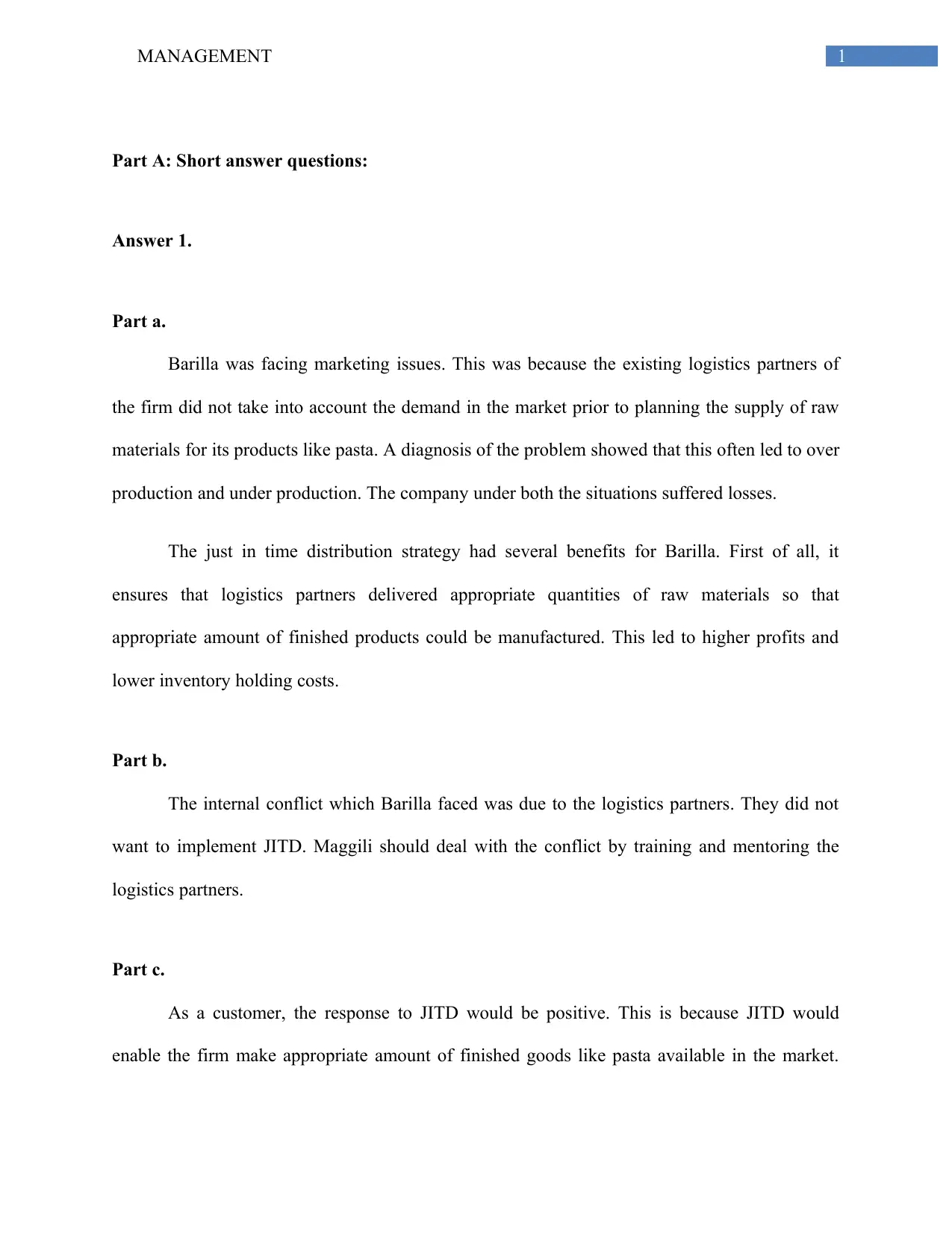
1MANAGEMENT
Part A: Short answer questions:
Answer 1.
Part a.
Barilla was facing marketing issues. This was because the existing logistics partners of
the firm did not take into account the demand in the market prior to planning the supply of raw
materials for its products like pasta. A diagnosis of the problem showed that this often led to over
production and under production. The company under both the situations suffered losses.
The just in time distribution strategy had several benefits for Barilla. First of all, it
ensures that logistics partners delivered appropriate quantities of raw materials so that
appropriate amount of finished products could be manufactured. This led to higher profits and
lower inventory holding costs.
Part b.
The internal conflict which Barilla faced was due to the logistics partners. They did not
want to implement JITD. Maggili should deal with the conflict by training and mentoring the
logistics partners.
Part c.
As a customer, the response to JITD would be positive. This is because JITD would
enable the firm make appropriate amount of finished goods like pasta available in the market.
Part A: Short answer questions:
Answer 1.
Part a.
Barilla was facing marketing issues. This was because the existing logistics partners of
the firm did not take into account the demand in the market prior to planning the supply of raw
materials for its products like pasta. A diagnosis of the problem showed that this often led to over
production and under production. The company under both the situations suffered losses.
The just in time distribution strategy had several benefits for Barilla. First of all, it
ensures that logistics partners delivered appropriate quantities of raw materials so that
appropriate amount of finished products could be manufactured. This led to higher profits and
lower inventory holding costs.
Part b.
The internal conflict which Barilla faced was due to the logistics partners. They did not
want to implement JITD. Maggili should deal with the conflict by training and mentoring the
logistics partners.
Part c.
As a customer, the response to JITD would be positive. This is because JITD would
enable the firm make appropriate amount of finished goods like pasta available in the market.
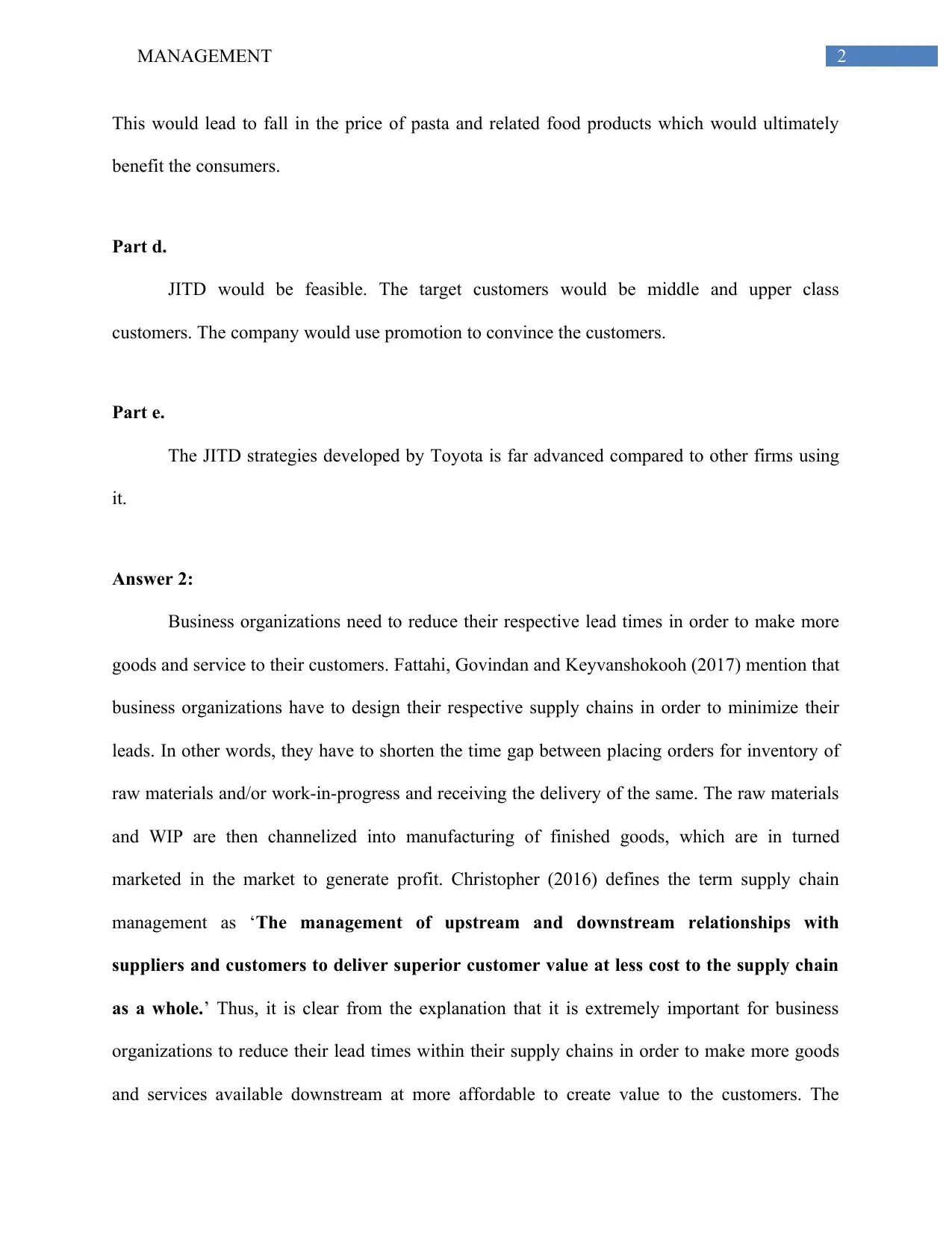
2MANAGEMENT
This would lead to fall in the price of pasta and related food products which would ultimately
benefit the consumers.
Part d.
JITD would be feasible. The target customers would be middle and upper class
customers. The company would use promotion to convince the customers.
Part e.
The JITD strategies developed by Toyota is far advanced compared to other firms using
it.
Answer 2:
Business organizations need to reduce their respective lead times in order to make more
goods and service to their customers. Fattahi, Govindan and Keyvanshokooh (2017) mention that
business organizations have to design their respective supply chains in order to minimize their
leads. In other words, they have to shorten the time gap between placing orders for inventory of
raw materials and/or work-in-progress and receiving the delivery of the same. The raw materials
and WIP are then channelized into manufacturing of finished goods, which are in turned
marketed in the market to generate profit. Christopher (2016) defines the term supply chain
management as ‘The management of upstream and downstream relationships with
suppliers and customers to deliver superior customer value at less cost to the supply chain
as a whole.’ Thus, it is clear from the explanation that it is extremely important for business
organizations to reduce their lead times within their supply chains in order to make more goods
and services available downstream at more affordable to create value to the customers. The
This would lead to fall in the price of pasta and related food products which would ultimately
benefit the consumers.
Part d.
JITD would be feasible. The target customers would be middle and upper class
customers. The company would use promotion to convince the customers.
Part e.
The JITD strategies developed by Toyota is far advanced compared to other firms using
it.
Answer 2:
Business organizations need to reduce their respective lead times in order to make more
goods and service to their customers. Fattahi, Govindan and Keyvanshokooh (2017) mention that
business organizations have to design their respective supply chains in order to minimize their
leads. In other words, they have to shorten the time gap between placing orders for inventory of
raw materials and/or work-in-progress and receiving the delivery of the same. The raw materials
and WIP are then channelized into manufacturing of finished goods, which are in turned
marketed in the market to generate profit. Christopher (2016) defines the term supply chain
management as ‘The management of upstream and downstream relationships with
suppliers and customers to deliver superior customer value at less cost to the supply chain
as a whole.’ Thus, it is clear from the explanation that it is extremely important for business
organizations to reduce their lead times within their supply chains in order to make more goods
and services available downstream at more affordable to create value to the customers. The
⊘ This is a preview!⊘
Do you want full access?
Subscribe today to unlock all pages.

Trusted by 1+ million students worldwide
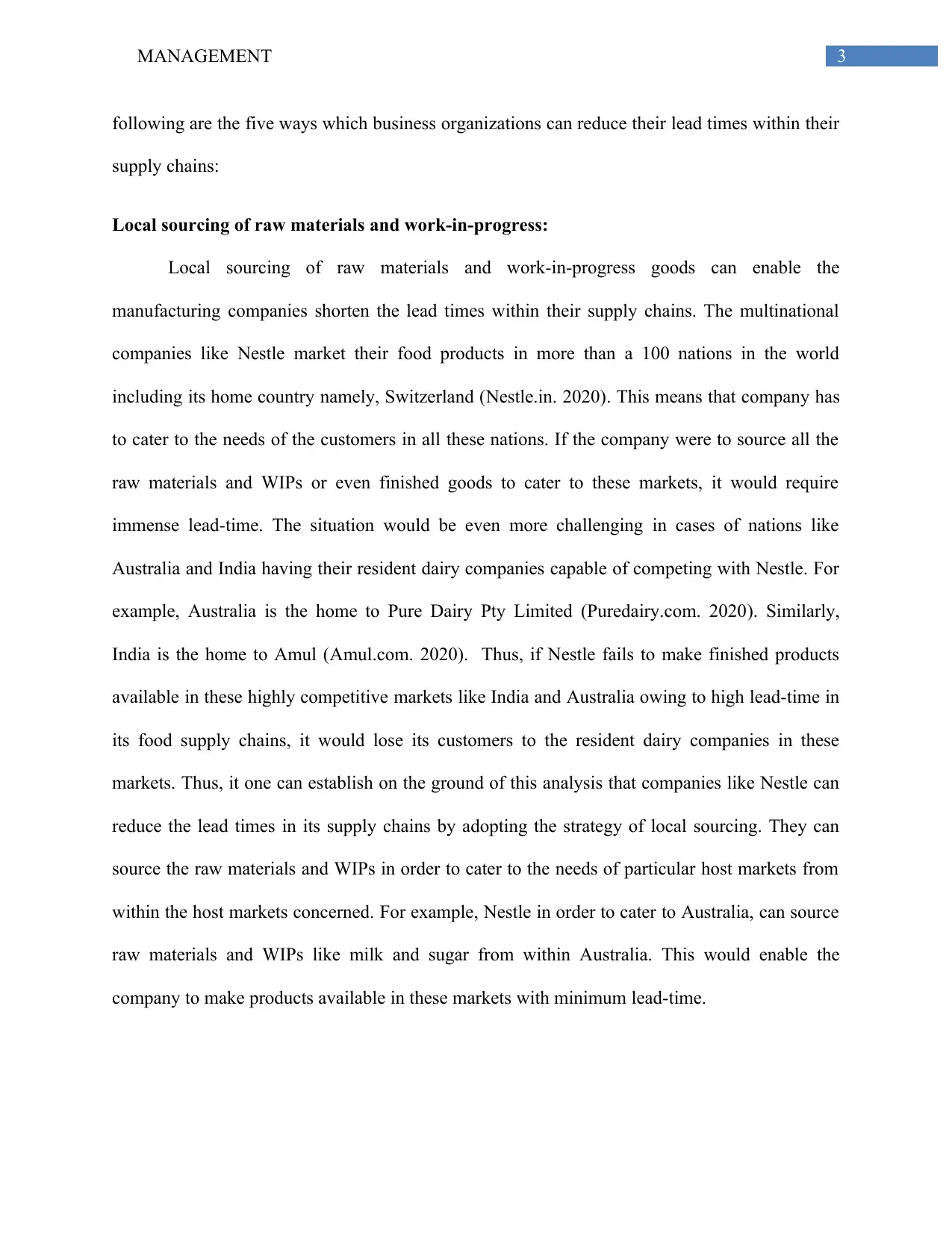
3MANAGEMENT
following are the five ways which business organizations can reduce their lead times within their
supply chains:
Local sourcing of raw materials and work-in-progress:
Local sourcing of raw materials and work-in-progress goods can enable the
manufacturing companies shorten the lead times within their supply chains. The multinational
companies like Nestle market their food products in more than a 100 nations in the world
including its home country namely, Switzerland (Nestle.in. 2020). This means that company has
to cater to the needs of the customers in all these nations. If the company were to source all the
raw materials and WIPs or even finished goods to cater to these markets, it would require
immense lead-time. The situation would be even more challenging in cases of nations like
Australia and India having their resident dairy companies capable of competing with Nestle. For
example, Australia is the home to Pure Dairy Pty Limited (Puredairy.com. 2020). Similarly,
India is the home to Amul (Amul.com. 2020). Thus, if Nestle fails to make finished products
available in these highly competitive markets like India and Australia owing to high lead-time in
its food supply chains, it would lose its customers to the resident dairy companies in these
markets. Thus, it one can establish on the ground of this analysis that companies like Nestle can
reduce the lead times in its supply chains by adopting the strategy of local sourcing. They can
source the raw materials and WIPs in order to cater to the needs of particular host markets from
within the host markets concerned. For example, Nestle in order to cater to Australia, can source
raw materials and WIPs like milk and sugar from within Australia. This would enable the
company to make products available in these markets with minimum lead-time.
following are the five ways which business organizations can reduce their lead times within their
supply chains:
Local sourcing of raw materials and work-in-progress:
Local sourcing of raw materials and work-in-progress goods can enable the
manufacturing companies shorten the lead times within their supply chains. The multinational
companies like Nestle market their food products in more than a 100 nations in the world
including its home country namely, Switzerland (Nestle.in. 2020). This means that company has
to cater to the needs of the customers in all these nations. If the company were to source all the
raw materials and WIPs or even finished goods to cater to these markets, it would require
immense lead-time. The situation would be even more challenging in cases of nations like
Australia and India having their resident dairy companies capable of competing with Nestle. For
example, Australia is the home to Pure Dairy Pty Limited (Puredairy.com. 2020). Similarly,
India is the home to Amul (Amul.com. 2020). Thus, if Nestle fails to make finished products
available in these highly competitive markets like India and Australia owing to high lead-time in
its food supply chains, it would lose its customers to the resident dairy companies in these
markets. Thus, it one can establish on the ground of this analysis that companies like Nestle can
reduce the lead times in its supply chains by adopting the strategy of local sourcing. They can
source the raw materials and WIPs in order to cater to the needs of particular host markets from
within the host markets concerned. For example, Nestle in order to cater to Australia, can source
raw materials and WIPs like milk and sugar from within Australia. This would enable the
company to make products available in these markets with minimum lead-time.
Paraphrase This Document
Need a fresh take? Get an instant paraphrase of this document with our AI Paraphraser
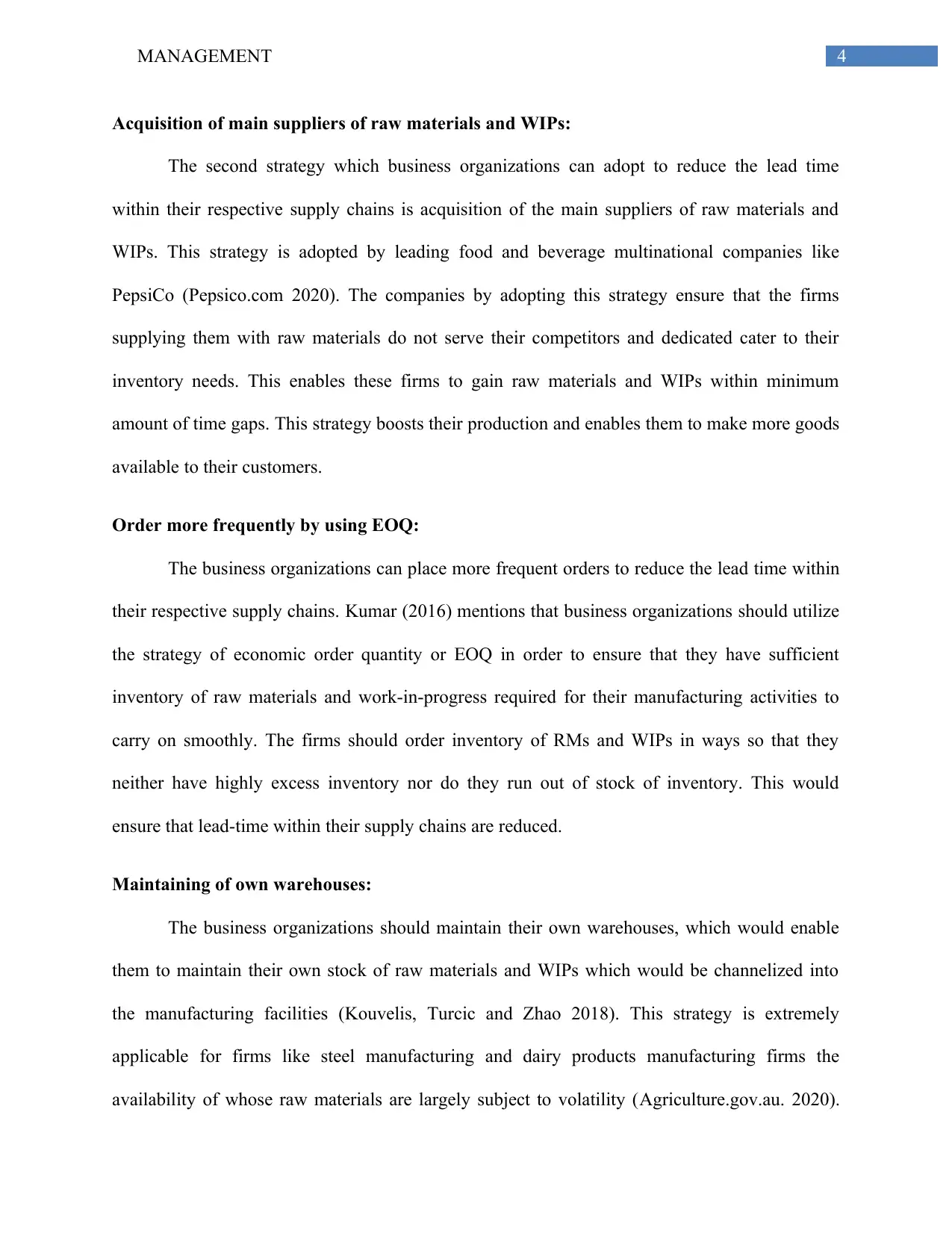
4MANAGEMENT
Acquisition of main suppliers of raw materials and WIPs:
The second strategy which business organizations can adopt to reduce the lead time
within their respective supply chains is acquisition of the main suppliers of raw materials and
WIPs. This strategy is adopted by leading food and beverage multinational companies like
PepsiCo (Pepsico.com 2020). The companies by adopting this strategy ensure that the firms
supplying them with raw materials do not serve their competitors and dedicated cater to their
inventory needs. This enables these firms to gain raw materials and WIPs within minimum
amount of time gaps. This strategy boosts their production and enables them to make more goods
available to their customers.
Order more frequently by using EOQ:
The business organizations can place more frequent orders to reduce the lead time within
their respective supply chains. Kumar (2016) mentions that business organizations should utilize
the strategy of economic order quantity or EOQ in order to ensure that they have sufficient
inventory of raw materials and work-in-progress required for their manufacturing activities to
carry on smoothly. The firms should order inventory of RMs and WIPs in ways so that they
neither have highly excess inventory nor do they run out of stock of inventory. This would
ensure that lead-time within their supply chains are reduced.
Maintaining of own warehouses:
The business organizations should maintain their own warehouses, which would enable
them to maintain their own stock of raw materials and WIPs which would be channelized into
the manufacturing facilities (Kouvelis, Turcic and Zhao 2018). This strategy is extremely
applicable for firms like steel manufacturing and dairy products manufacturing firms the
availability of whose raw materials are largely subject to volatility (Agriculture.gov.au. 2020).
Acquisition of main suppliers of raw materials and WIPs:
The second strategy which business organizations can adopt to reduce the lead time
within their respective supply chains is acquisition of the main suppliers of raw materials and
WIPs. This strategy is adopted by leading food and beverage multinational companies like
PepsiCo (Pepsico.com 2020). The companies by adopting this strategy ensure that the firms
supplying them with raw materials do not serve their competitors and dedicated cater to their
inventory needs. This enables these firms to gain raw materials and WIPs within minimum
amount of time gaps. This strategy boosts their production and enables them to make more goods
available to their customers.
Order more frequently by using EOQ:
The business organizations can place more frequent orders to reduce the lead time within
their respective supply chains. Kumar (2016) mentions that business organizations should utilize
the strategy of economic order quantity or EOQ in order to ensure that they have sufficient
inventory of raw materials and work-in-progress required for their manufacturing activities to
carry on smoothly. The firms should order inventory of RMs and WIPs in ways so that they
neither have highly excess inventory nor do they run out of stock of inventory. This would
ensure that lead-time within their supply chains are reduced.
Maintaining of own warehouses:
The business organizations should maintain their own warehouses, which would enable
them to maintain their own stock of raw materials and WIPs which would be channelized into
the manufacturing facilities (Kouvelis, Turcic and Zhao 2018). This strategy is extremely
applicable for firms like steel manufacturing and dairy products manufacturing firms the
availability of whose raw materials are largely subject to volatility (Agriculture.gov.au. 2020).
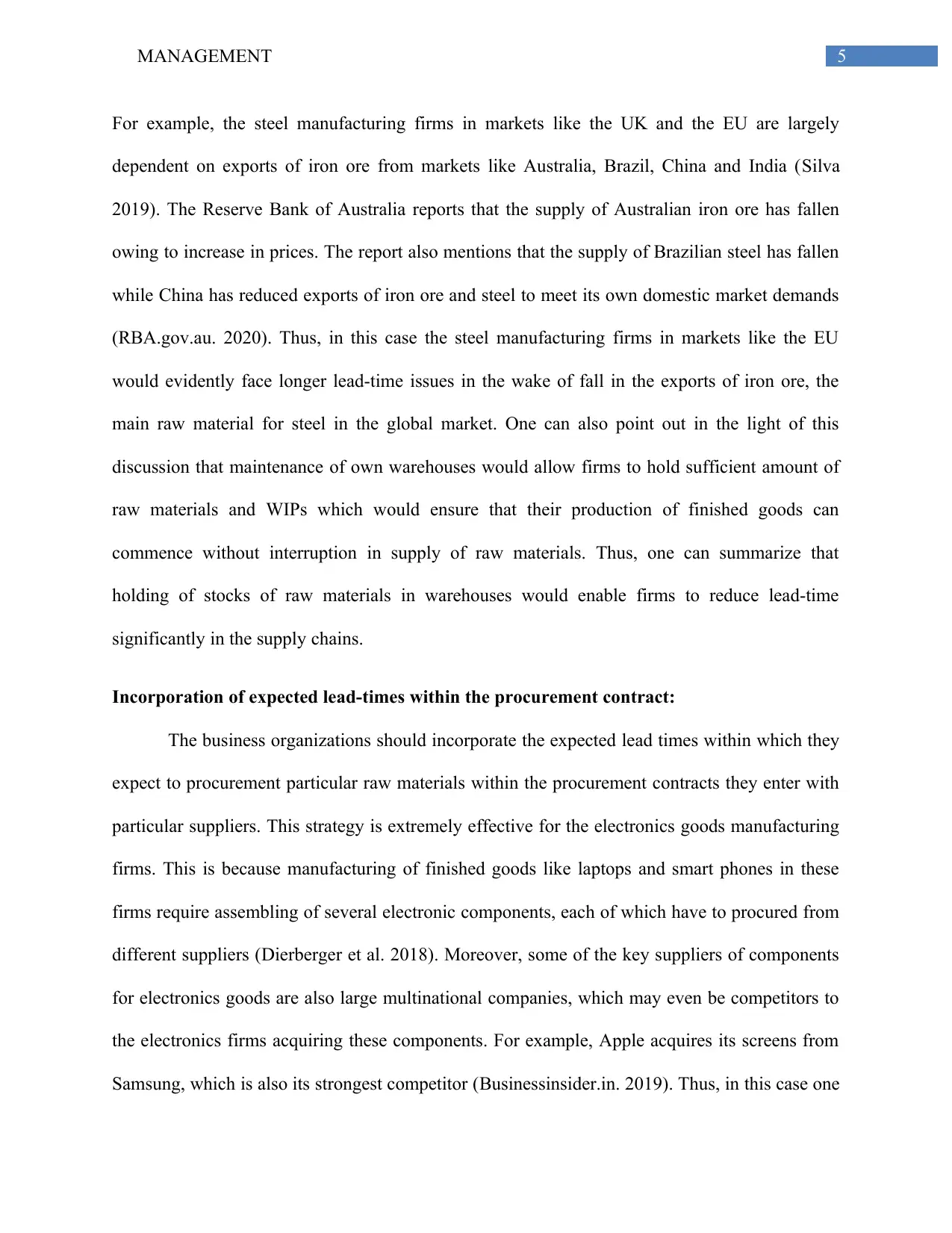
5MANAGEMENT
For example, the steel manufacturing firms in markets like the UK and the EU are largely
dependent on exports of iron ore from markets like Australia, Brazil, China and India (Silva
2019). The Reserve Bank of Australia reports that the supply of Australian iron ore has fallen
owing to increase in prices. The report also mentions that the supply of Brazilian steel has fallen
while China has reduced exports of iron ore and steel to meet its own domestic market demands
(RBA.gov.au. 2020). Thus, in this case the steel manufacturing firms in markets like the EU
would evidently face longer lead-time issues in the wake of fall in the exports of iron ore, the
main raw material for steel in the global market. One can also point out in the light of this
discussion that maintenance of own warehouses would allow firms to hold sufficient amount of
raw materials and WIPs which would ensure that their production of finished goods can
commence without interruption in supply of raw materials. Thus, one can summarize that
holding of stocks of raw materials in warehouses would enable firms to reduce lead-time
significantly in the supply chains.
Incorporation of expected lead-times within the procurement contract:
The business organizations should incorporate the expected lead times within which they
expect to procurement particular raw materials within the procurement contracts they enter with
particular suppliers. This strategy is extremely effective for the electronics goods manufacturing
firms. This is because manufacturing of finished goods like laptops and smart phones in these
firms require assembling of several electronic components, each of which have to procured from
different suppliers (Dierberger et al. 2018). Moreover, some of the key suppliers of components
for electronics goods are also large multinational companies, which may even be competitors to
the electronics firms acquiring these components. For example, Apple acquires its screens from
Samsung, which is also its strongest competitor (Businessinsider.in. 2019). Thus, in this case one
For example, the steel manufacturing firms in markets like the UK and the EU are largely
dependent on exports of iron ore from markets like Australia, Brazil, China and India (Silva
2019). The Reserve Bank of Australia reports that the supply of Australian iron ore has fallen
owing to increase in prices. The report also mentions that the supply of Brazilian steel has fallen
while China has reduced exports of iron ore and steel to meet its own domestic market demands
(RBA.gov.au. 2020). Thus, in this case the steel manufacturing firms in markets like the EU
would evidently face longer lead-time issues in the wake of fall in the exports of iron ore, the
main raw material for steel in the global market. One can also point out in the light of this
discussion that maintenance of own warehouses would allow firms to hold sufficient amount of
raw materials and WIPs which would ensure that their production of finished goods can
commence without interruption in supply of raw materials. Thus, one can summarize that
holding of stocks of raw materials in warehouses would enable firms to reduce lead-time
significantly in the supply chains.
Incorporation of expected lead-times within the procurement contract:
The business organizations should incorporate the expected lead times within which they
expect to procurement particular raw materials within the procurement contracts they enter with
particular suppliers. This strategy is extremely effective for the electronics goods manufacturing
firms. This is because manufacturing of finished goods like laptops and smart phones in these
firms require assembling of several electronic components, each of which have to procured from
different suppliers (Dierberger et al. 2018). Moreover, some of the key suppliers of components
for electronics goods are also large multinational companies, which may even be competitors to
the electronics firms acquiring these components. For example, Apple acquires its screens from
Samsung, which is also its strongest competitor (Businessinsider.in. 2019). Thus, in this case one
⊘ This is a preview!⊘
Do you want full access?
Subscribe today to unlock all pages.

Trusted by 1+ million students worldwide
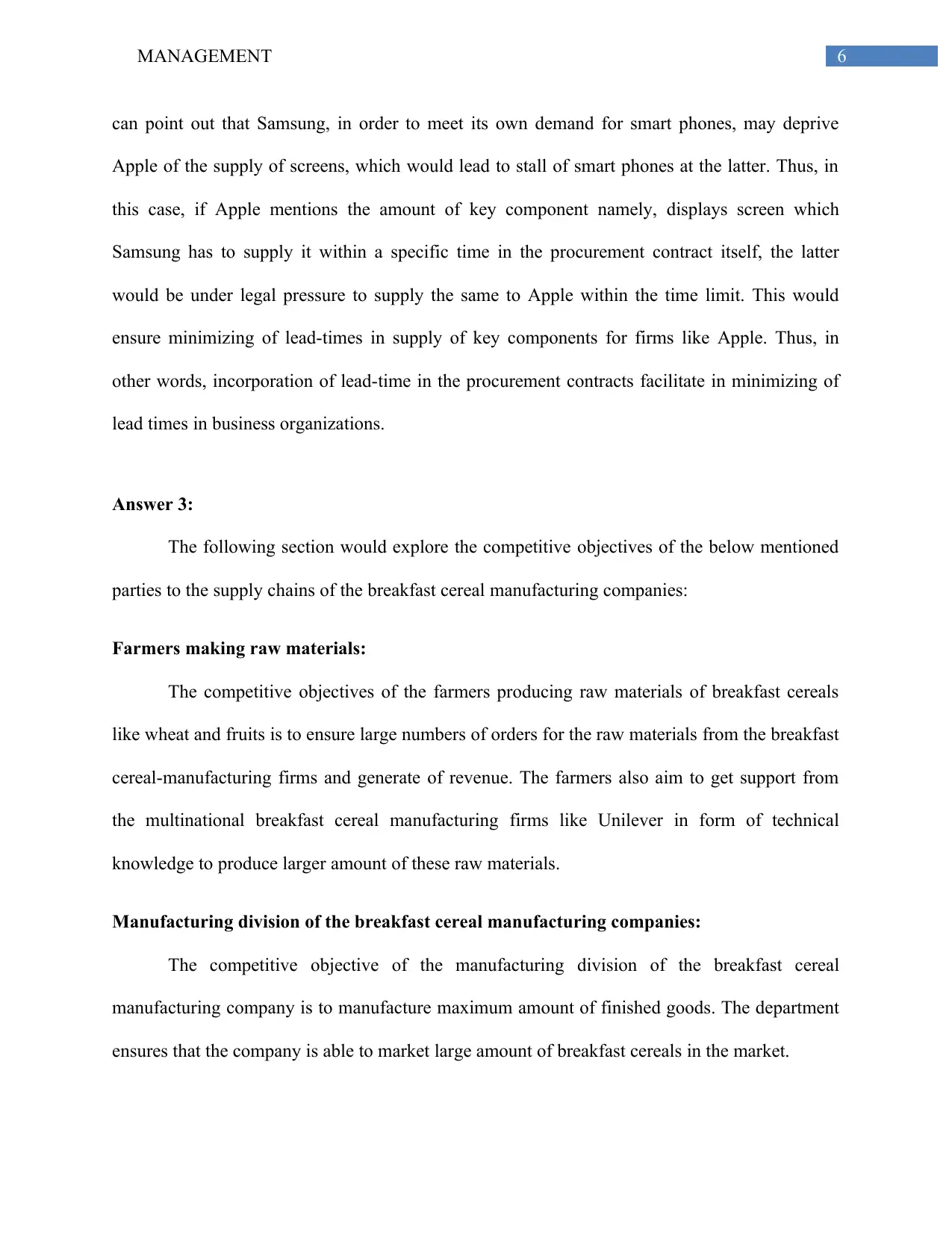
6MANAGEMENT
can point out that Samsung, in order to meet its own demand for smart phones, may deprive
Apple of the supply of screens, which would lead to stall of smart phones at the latter. Thus, in
this case, if Apple mentions the amount of key component namely, displays screen which
Samsung has to supply it within a specific time in the procurement contract itself, the latter
would be under legal pressure to supply the same to Apple within the time limit. This would
ensure minimizing of lead-times in supply of key components for firms like Apple. Thus, in
other words, incorporation of lead-time in the procurement contracts facilitate in minimizing of
lead times in business organizations.
Answer 3:
The following section would explore the competitive objectives of the below mentioned
parties to the supply chains of the breakfast cereal manufacturing companies:
Farmers making raw materials:
The competitive objectives of the farmers producing raw materials of breakfast cereals
like wheat and fruits is to ensure large numbers of orders for the raw materials from the breakfast
cereal-manufacturing firms and generate of revenue. The farmers also aim to get support from
the multinational breakfast cereal manufacturing firms like Unilever in form of technical
knowledge to produce larger amount of these raw materials.
Manufacturing division of the breakfast cereal manufacturing companies:
The competitive objective of the manufacturing division of the breakfast cereal
manufacturing company is to manufacture maximum amount of finished goods. The department
ensures that the company is able to market large amount of breakfast cereals in the market.
can point out that Samsung, in order to meet its own demand for smart phones, may deprive
Apple of the supply of screens, which would lead to stall of smart phones at the latter. Thus, in
this case, if Apple mentions the amount of key component namely, displays screen which
Samsung has to supply it within a specific time in the procurement contract itself, the latter
would be under legal pressure to supply the same to Apple within the time limit. This would
ensure minimizing of lead-times in supply of key components for firms like Apple. Thus, in
other words, incorporation of lead-time in the procurement contracts facilitate in minimizing of
lead times in business organizations.
Answer 3:
The following section would explore the competitive objectives of the below mentioned
parties to the supply chains of the breakfast cereal manufacturing companies:
Farmers making raw materials:
The competitive objectives of the farmers producing raw materials of breakfast cereals
like wheat and fruits is to ensure large numbers of orders for the raw materials from the breakfast
cereal-manufacturing firms and generate of revenue. The farmers also aim to get support from
the multinational breakfast cereal manufacturing firms like Unilever in form of technical
knowledge to produce larger amount of these raw materials.
Manufacturing division of the breakfast cereal manufacturing companies:
The competitive objective of the manufacturing division of the breakfast cereal
manufacturing company is to manufacture maximum amount of finished goods. The department
ensures that the company is able to market large amount of breakfast cereals in the market.
Paraphrase This Document
Need a fresh take? Get an instant paraphrase of this document with our AI Paraphraser
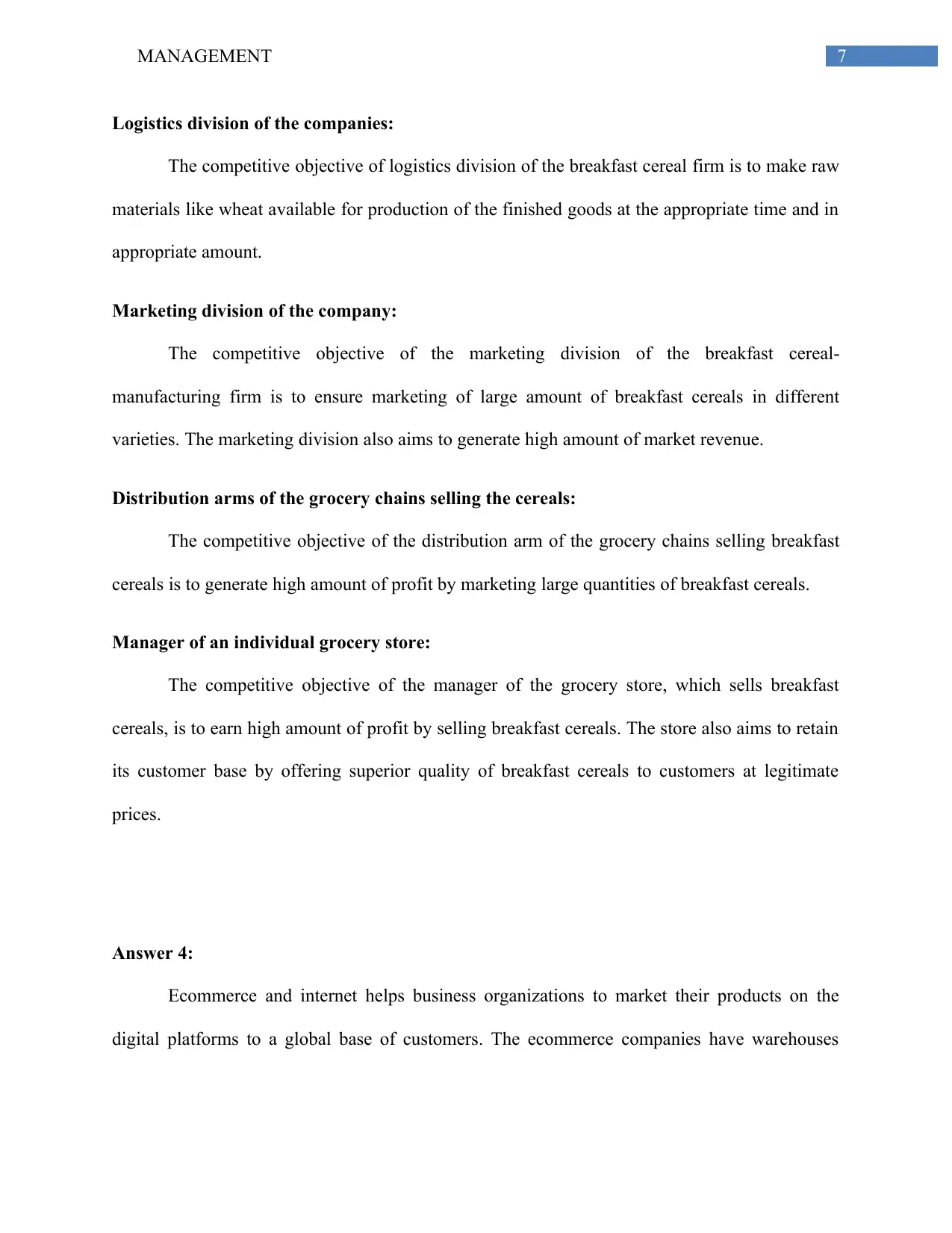
7MANAGEMENT
Logistics division of the companies:
The competitive objective of logistics division of the breakfast cereal firm is to make raw
materials like wheat available for production of the finished goods at the appropriate time and in
appropriate amount.
Marketing division of the company:
The competitive objective of the marketing division of the breakfast cereal-
manufacturing firm is to ensure marketing of large amount of breakfast cereals in different
varieties. The marketing division also aims to generate high amount of market revenue.
Distribution arms of the grocery chains selling the cereals:
The competitive objective of the distribution arm of the grocery chains selling breakfast
cereals is to generate high amount of profit by marketing large quantities of breakfast cereals.
Manager of an individual grocery store:
The competitive objective of the manager of the grocery store, which sells breakfast
cereals, is to earn high amount of profit by selling breakfast cereals. The store also aims to retain
its customer base by offering superior quality of breakfast cereals to customers at legitimate
prices.
Answer 4:
Ecommerce and internet helps business organizations to market their products on the
digital platforms to a global base of customers. The ecommerce companies have warehouses
Logistics division of the companies:
The competitive objective of logistics division of the breakfast cereal firm is to make raw
materials like wheat available for production of the finished goods at the appropriate time and in
appropriate amount.
Marketing division of the company:
The competitive objective of the marketing division of the breakfast cereal-
manufacturing firm is to ensure marketing of large amount of breakfast cereals in different
varieties. The marketing division also aims to generate high amount of market revenue.
Distribution arms of the grocery chains selling the cereals:
The competitive objective of the distribution arm of the grocery chains selling breakfast
cereals is to generate high amount of profit by marketing large quantities of breakfast cereals.
Manager of an individual grocery store:
The competitive objective of the manager of the grocery store, which sells breakfast
cereals, is to earn high amount of profit by selling breakfast cereals. The store also aims to retain
its customer base by offering superior quality of breakfast cereals to customers at legitimate
prices.
Answer 4:
Ecommerce and internet helps business organizations to market their products on the
digital platforms to a global base of customers. The ecommerce companies have warehouses
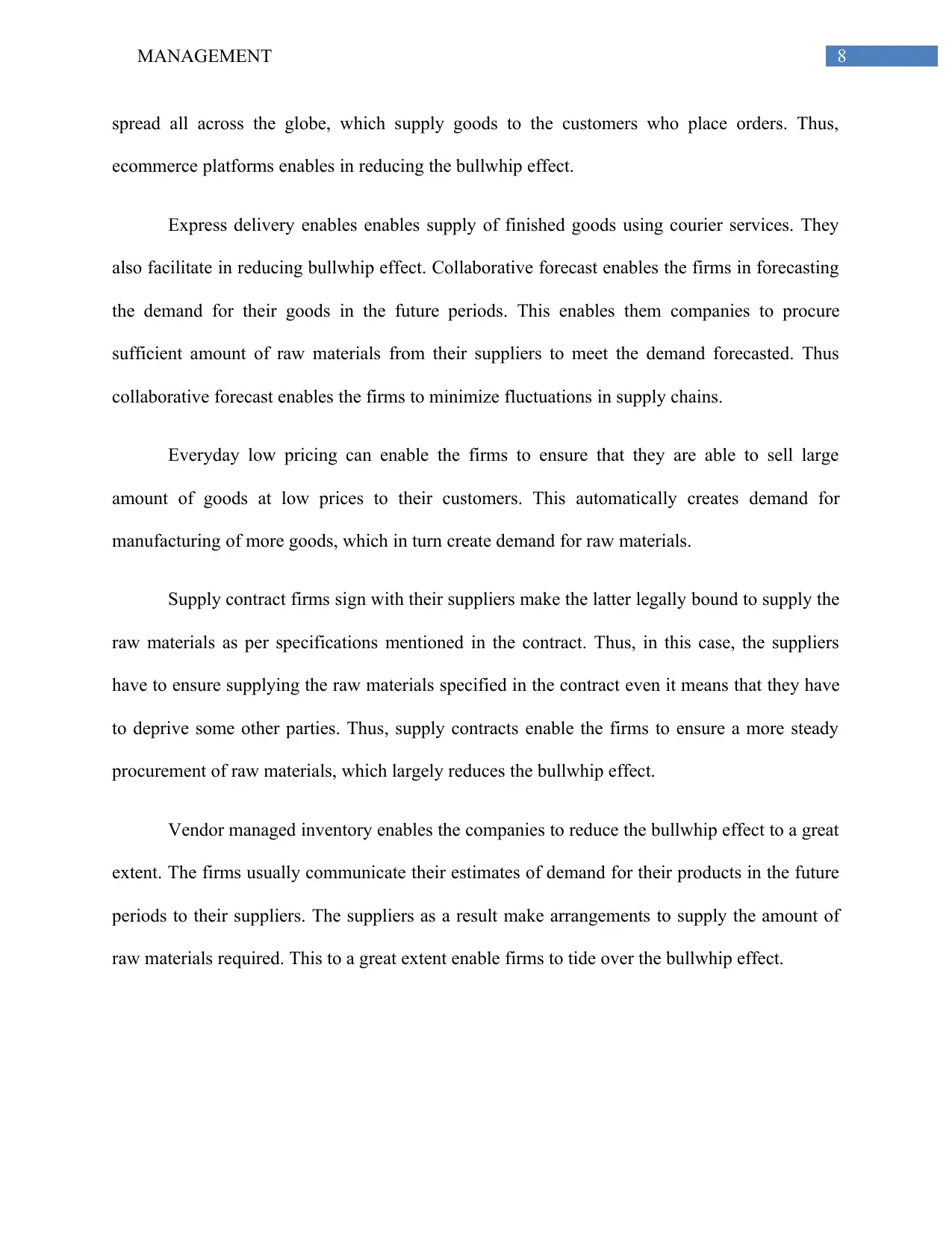
8MANAGEMENT
spread all across the globe, which supply goods to the customers who place orders. Thus,
ecommerce platforms enables in reducing the bullwhip effect.
Express delivery enables enables supply of finished goods using courier services. They
also facilitate in reducing bullwhip effect. Collaborative forecast enables the firms in forecasting
the demand for their goods in the future periods. This enables them companies to procure
sufficient amount of raw materials from their suppliers to meet the demand forecasted. Thus
collaborative forecast enables the firms to minimize fluctuations in supply chains.
Everyday low pricing can enable the firms to ensure that they are able to sell large
amount of goods at low prices to their customers. This automatically creates demand for
manufacturing of more goods, which in turn create demand for raw materials.
Supply contract firms sign with their suppliers make the latter legally bound to supply the
raw materials as per specifications mentioned in the contract. Thus, in this case, the suppliers
have to ensure supplying the raw materials specified in the contract even it means that they have
to deprive some other parties. Thus, supply contracts enable the firms to ensure a more steady
procurement of raw materials, which largely reduces the bullwhip effect.
Vendor managed inventory enables the companies to reduce the bullwhip effect to a great
extent. The firms usually communicate their estimates of demand for their products in the future
periods to their suppliers. The suppliers as a result make arrangements to supply the amount of
raw materials required. This to a great extent enable firms to tide over the bullwhip effect.
spread all across the globe, which supply goods to the customers who place orders. Thus,
ecommerce platforms enables in reducing the bullwhip effect.
Express delivery enables enables supply of finished goods using courier services. They
also facilitate in reducing bullwhip effect. Collaborative forecast enables the firms in forecasting
the demand for their goods in the future periods. This enables them companies to procure
sufficient amount of raw materials from their suppliers to meet the demand forecasted. Thus
collaborative forecast enables the firms to minimize fluctuations in supply chains.
Everyday low pricing can enable the firms to ensure that they are able to sell large
amount of goods at low prices to their customers. This automatically creates demand for
manufacturing of more goods, which in turn create demand for raw materials.
Supply contract firms sign with their suppliers make the latter legally bound to supply the
raw materials as per specifications mentioned in the contract. Thus, in this case, the suppliers
have to ensure supplying the raw materials specified in the contract even it means that they have
to deprive some other parties. Thus, supply contracts enable the firms to ensure a more steady
procurement of raw materials, which largely reduces the bullwhip effect.
Vendor managed inventory enables the companies to reduce the bullwhip effect to a great
extent. The firms usually communicate their estimates of demand for their products in the future
periods to their suppliers. The suppliers as a result make arrangements to supply the amount of
raw materials required. This to a great extent enable firms to tide over the bullwhip effect.
⊘ This is a preview!⊘
Do you want full access?
Subscribe today to unlock all pages.

Trusted by 1+ million students worldwide
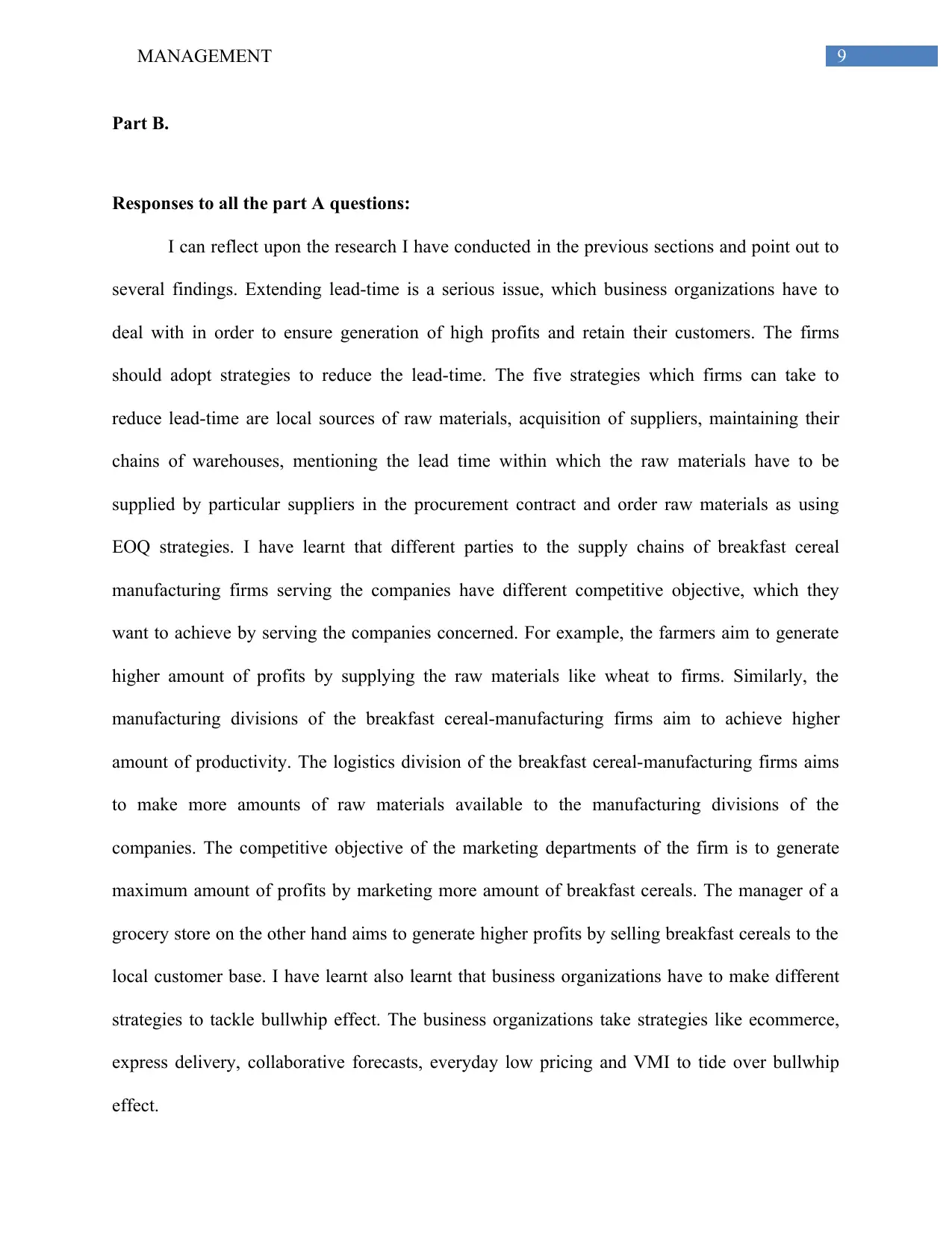
9MANAGEMENT
Part B.
Responses to all the part A questions:
I can reflect upon the research I have conducted in the previous sections and point out to
several findings. Extending lead-time is a serious issue, which business organizations have to
deal with in order to ensure generation of high profits and retain their customers. The firms
should adopt strategies to reduce the lead-time. The five strategies which firms can take to
reduce lead-time are local sources of raw materials, acquisition of suppliers, maintaining their
chains of warehouses, mentioning the lead time within which the raw materials have to be
supplied by particular suppliers in the procurement contract and order raw materials as using
EOQ strategies. I have learnt that different parties to the supply chains of breakfast cereal
manufacturing firms serving the companies have different competitive objective, which they
want to achieve by serving the companies concerned. For example, the farmers aim to generate
higher amount of profits by supplying the raw materials like wheat to firms. Similarly, the
manufacturing divisions of the breakfast cereal-manufacturing firms aim to achieve higher
amount of productivity. The logistics division of the breakfast cereal-manufacturing firms aims
to make more amounts of raw materials available to the manufacturing divisions of the
companies. The competitive objective of the marketing departments of the firm is to generate
maximum amount of profits by marketing more amount of breakfast cereals. The manager of a
grocery store on the other hand aims to generate higher profits by selling breakfast cereals to the
local customer base. I have learnt also learnt that business organizations have to make different
strategies to tackle bullwhip effect. The business organizations take strategies like ecommerce,
express delivery, collaborative forecasts, everyday low pricing and VMI to tide over bullwhip
effect.
Part B.
Responses to all the part A questions:
I can reflect upon the research I have conducted in the previous sections and point out to
several findings. Extending lead-time is a serious issue, which business organizations have to
deal with in order to ensure generation of high profits and retain their customers. The firms
should adopt strategies to reduce the lead-time. The five strategies which firms can take to
reduce lead-time are local sources of raw materials, acquisition of suppliers, maintaining their
chains of warehouses, mentioning the lead time within which the raw materials have to be
supplied by particular suppliers in the procurement contract and order raw materials as using
EOQ strategies. I have learnt that different parties to the supply chains of breakfast cereal
manufacturing firms serving the companies have different competitive objective, which they
want to achieve by serving the companies concerned. For example, the farmers aim to generate
higher amount of profits by supplying the raw materials like wheat to firms. Similarly, the
manufacturing divisions of the breakfast cereal-manufacturing firms aim to achieve higher
amount of productivity. The logistics division of the breakfast cereal-manufacturing firms aims
to make more amounts of raw materials available to the manufacturing divisions of the
companies. The competitive objective of the marketing departments of the firm is to generate
maximum amount of profits by marketing more amount of breakfast cereals. The manager of a
grocery store on the other hand aims to generate higher profits by selling breakfast cereals to the
local customer base. I have learnt also learnt that business organizations have to make different
strategies to tackle bullwhip effect. The business organizations take strategies like ecommerce,
express delivery, collaborative forecasts, everyday low pricing and VMI to tide over bullwhip
effect.
Paraphrase This Document
Need a fresh take? Get an instant paraphrase of this document with our AI Paraphraser
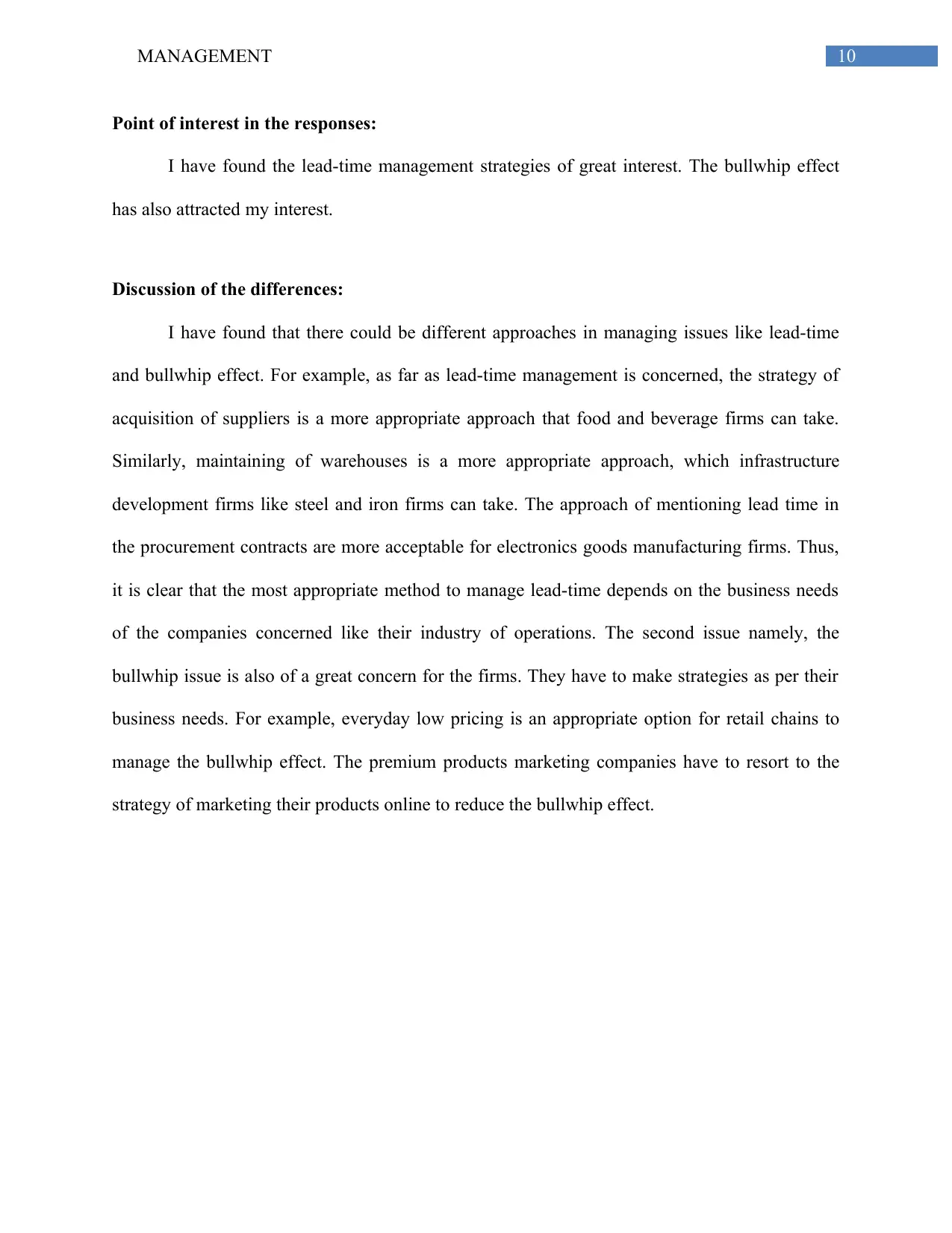
10MANAGEMENT
Point of interest in the responses:
I have found the lead-time management strategies of great interest. The bullwhip effect
has also attracted my interest.
Discussion of the differences:
I have found that there could be different approaches in managing issues like lead-time
and bullwhip effect. For example, as far as lead-time management is concerned, the strategy of
acquisition of suppliers is a more appropriate approach that food and beverage firms can take.
Similarly, maintaining of warehouses is a more appropriate approach, which infrastructure
development firms like steel and iron firms can take. The approach of mentioning lead time in
the procurement contracts are more acceptable for electronics goods manufacturing firms. Thus,
it is clear that the most appropriate method to manage lead-time depends on the business needs
of the companies concerned like their industry of operations. The second issue namely, the
bullwhip issue is also of a great concern for the firms. They have to make strategies as per their
business needs. For example, everyday low pricing is an appropriate option for retail chains to
manage the bullwhip effect. The premium products marketing companies have to resort to the
strategy of marketing their products online to reduce the bullwhip effect.
Point of interest in the responses:
I have found the lead-time management strategies of great interest. The bullwhip effect
has also attracted my interest.
Discussion of the differences:
I have found that there could be different approaches in managing issues like lead-time
and bullwhip effect. For example, as far as lead-time management is concerned, the strategy of
acquisition of suppliers is a more appropriate approach that food and beverage firms can take.
Similarly, maintaining of warehouses is a more appropriate approach, which infrastructure
development firms like steel and iron firms can take. The approach of mentioning lead time in
the procurement contracts are more acceptable for electronics goods manufacturing firms. Thus,
it is clear that the most appropriate method to manage lead-time depends on the business needs
of the companies concerned like their industry of operations. The second issue namely, the
bullwhip issue is also of a great concern for the firms. They have to make strategies as per their
business needs. For example, everyday low pricing is an appropriate option for retail chains to
manage the bullwhip effect. The premium products marketing companies have to resort to the
strategy of marketing their products online to reduce the bullwhip effect.
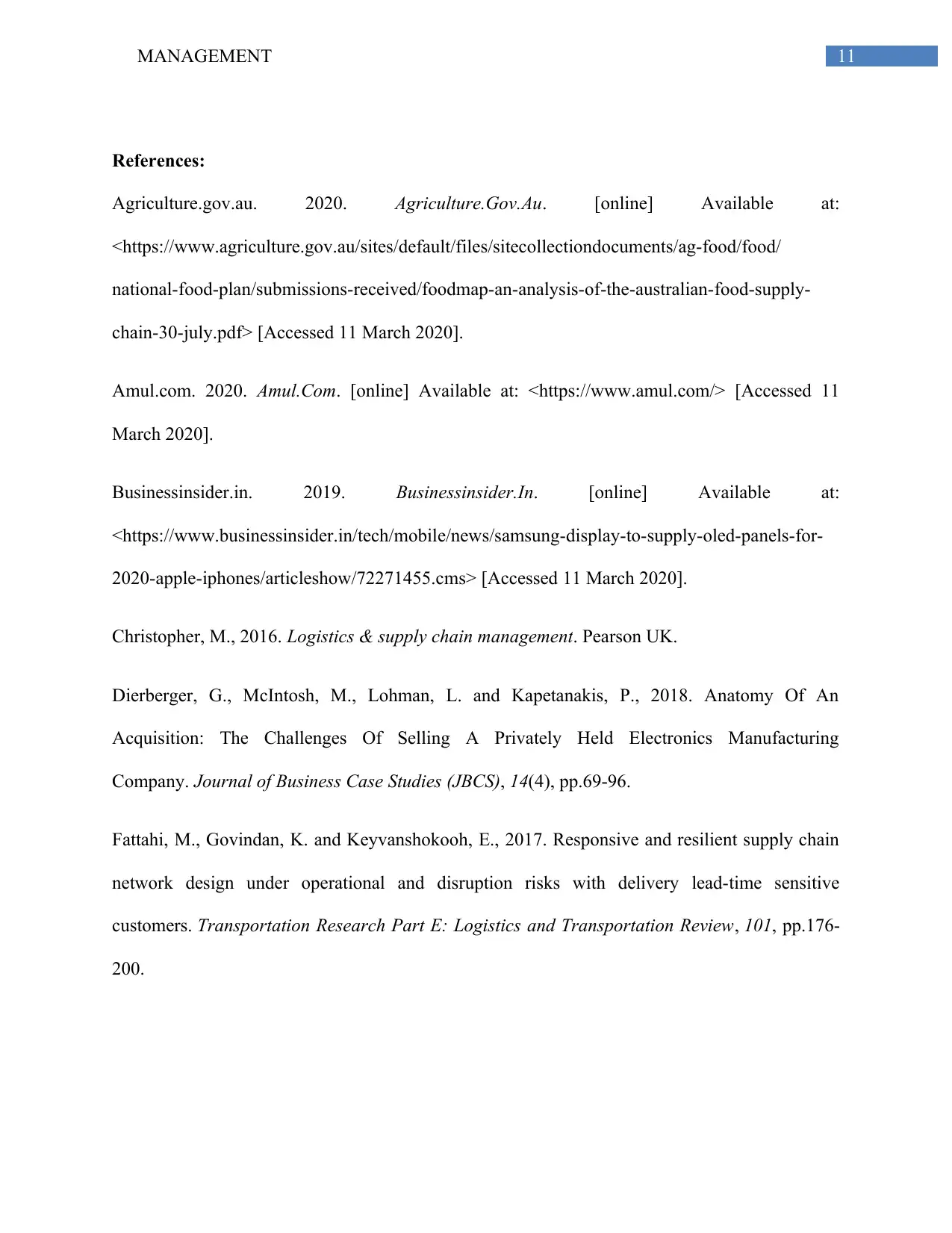
11MANAGEMENT
References:
Agriculture.gov.au. 2020. Agriculture.Gov.Au. [online] Available at:
<https://www.agriculture.gov.au/sites/default/files/sitecollectiondocuments/ag-food/food/
national-food-plan/submissions-received/foodmap-an-analysis-of-the-australian-food-supply-
chain-30-july.pdf> [Accessed 11 March 2020].
Amul.com. 2020. Amul.Com. [online] Available at: <https://www.amul.com/> [Accessed 11
March 2020].
Businessinsider.in. 2019. Businessinsider.In. [online] Available at:
<https://www.businessinsider.in/tech/mobile/news/samsung-display-to-supply-oled-panels-for-
2020-apple-iphones/articleshow/72271455.cms> [Accessed 11 March 2020].
Christopher, M., 2016. Logistics & supply chain management. Pearson UK.
Dierberger, G., McIntosh, M., Lohman, L. and Kapetanakis, P., 2018. Anatomy Of An
Acquisition: The Challenges Of Selling A Privately Held Electronics Manufacturing
Company. Journal of Business Case Studies (JBCS), 14(4), pp.69-96.
Fattahi, M., Govindan, K. and Keyvanshokooh, E., 2017. Responsive and resilient supply chain
network design under operational and disruption risks with delivery lead-time sensitive
customers. Transportation Research Part E: Logistics and Transportation Review, 101, pp.176-
200.
References:
Agriculture.gov.au. 2020. Agriculture.Gov.Au. [online] Available at:
<https://www.agriculture.gov.au/sites/default/files/sitecollectiondocuments/ag-food/food/
national-food-plan/submissions-received/foodmap-an-analysis-of-the-australian-food-supply-
chain-30-july.pdf> [Accessed 11 March 2020].
Amul.com. 2020. Amul.Com. [online] Available at: <https://www.amul.com/> [Accessed 11
March 2020].
Businessinsider.in. 2019. Businessinsider.In. [online] Available at:
<https://www.businessinsider.in/tech/mobile/news/samsung-display-to-supply-oled-panels-for-
2020-apple-iphones/articleshow/72271455.cms> [Accessed 11 March 2020].
Christopher, M., 2016. Logistics & supply chain management. Pearson UK.
Dierberger, G., McIntosh, M., Lohman, L. and Kapetanakis, P., 2018. Anatomy Of An
Acquisition: The Challenges Of Selling A Privately Held Electronics Manufacturing
Company. Journal of Business Case Studies (JBCS), 14(4), pp.69-96.
Fattahi, M., Govindan, K. and Keyvanshokooh, E., 2017. Responsive and resilient supply chain
network design under operational and disruption risks with delivery lead-time sensitive
customers. Transportation Research Part E: Logistics and Transportation Review, 101, pp.176-
200.
⊘ This is a preview!⊘
Do you want full access?
Subscribe today to unlock all pages.

Trusted by 1+ million students worldwide
1 out of 14
Related Documents
Your All-in-One AI-Powered Toolkit for Academic Success.
+13062052269
info@desklib.com
Available 24*7 on WhatsApp / Email
![[object Object]](/_next/static/media/star-bottom.7253800d.svg)
Unlock your academic potential
Copyright © 2020–2025 A2Z Services. All Rights Reserved. Developed and managed by ZUCOL.





